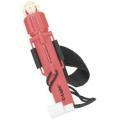Intro to Sea Survival | Life Rafts | Provisioning
All About Signals: Introduction
MAN HAS DEVISED NUMEROUS AIDS TO HELP the isolated survivor stand out against the elements to increase his chances of being rescued. Each type of signaling device has a specific design and purpose, as well as definite operating limitations. The prepared mariner, to be effective in most situations, should have a wide range of signaling devices to allow him the greatest chance of rescue.
The object of any signaling action or device is to create a spectacle and call attention to yourself. In an actual distress situation there is no illegal method of doing this. Any method or device that will get you rescued is justifiable.
As of January 1, 1981 , boats using American coastal waters or the Great Lakes were required by law to carry approved distress signals. Every boat 16 feet and over is required to carry approved day and night visual distress signals. (Boats under 16 feet are required to carry approved night signals between sunset and sunrise.) Al though the offshore cruiser does not normally fall within these jurisdictions, common sense and safety dictates that the cruising yacht also should be provisioned with an adequate supply of distress signals (see figure).
SIGNALS
Marine distress signals can be categorized according to design and purpose: those that are used to alert, and those that are used to locate.
Being able to alert the rescue party of your situation or whereabouts is essential, since the chance of being spotted accidentally is minimal. Moreover, the ocean can be so effectively deceiving to the human eye, that you also need a location-type signal that will enable the rescue craft to find you or “home” in on your position.
The effect of heavy swells on the visibility of any floating object in the ocean is well understood by sailors. Any mariner who has approached an unlit landfall at night can testify to the hazards and perceptual difficulties. Consider the problem in a survival situation at sea: A rocket flare is sighted four miles off to port in the distance, in heavy seas, and at night. The chance of an alerted ship pinpointing and reaching the position of the raft is slim, unless the raft can provide a constant location signal or reference.
A well-prepared supply of signals must contain both alert and locate devices. Although some distress signals can function as both, each device will usually serve one purpose more effectively.
Alert Signals
There are no strict distinctions between what would qualify as an alert signal or what qualifies as a locate signal. Obviously, any device that successfully alerts rescue can be called an alert signal. There are, however, certain devices that lend themselves more readily to the alert purpose.


Above: Signaling devices. More
examples and
to purchase info.
Any signal that is capable of attaining great heights (such as a rocket flare) is far more useful for alerting the attention of distant ships than most other types of visual signals. Your sighting distance on the ocean will be affected by the following: the curvature of the earth, the distance between your signal and the viewer, and the height of your signal. It’s important to understand how each of these factors influences the effectiveness of your signaling device (see image below).
Since a stranded raft is low in the water, it’s important to have a flare capable of reaching high altitudes. A flare would enable a ship out of your line of sight to be alerted, particularly in instances where because of the curvature of the earth, the use of other types of signaling devices would be ineffective. Flares that can attain great heights (such as the parachute, rocket and meteor flare) provide a longer and more conspicuous signal to the distant viewer.
Consider the following example:
At a distance of 21 miles, a meteor flare that is 250 feet above sea level will appear to the viewer as a brief signal on the surface of the ocean, because of the earth’s curvature. This same flare, at a distance of only ten miles, will appear to be about 125 feet above the surface (consequently producing a longer burn period of visibility for sighting and confirmation). In the case of a parachute flare at 1000 feet altitude, a viewer from a distance of 41 miles will see only a brief signal of light on the surface or horizon of the ocean.

Above: Due to the curvature of the earth, the survivor should be
aware that sighting distances are limited.
Whereas from half that distance, 20 miles, the flare will appear to be at about 500 feet altitude and will be visible for a considerably longer time.
Signals that can be seen at high altitudes are generally better to use when distance is a factor.
Locate Signals
Locate signals include any device that will provide and/or maintain a signal long enough for an approaching craft to get a fix on you. Your goal is to create a signal that a ship or aircraft can “home in” on.
Many distress devices can accomplish both alert and locate functions. A mirror, For example, can be used to alert an aircraft, as well as to furnish a constant signal, (weather permitting) for the aircraft to home in on. It’s a good idea to have adequate supplies of both types of signals to increase your chances of rescue.PREV: Medical Kit • NEXT: Visual Signaling Device • All Articles